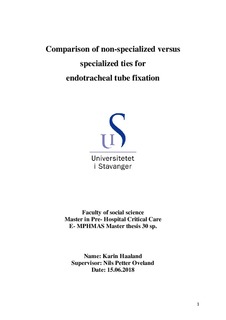| dc.contributor.advisor | Oveland, Nils Petter | |
| dc.contributor.author | Haaland, Karin | |
| dc.date.accessioned | 2019-01-18T09:43:12Z | |
| dc.date.available | 2019-01-18T09:43:12Z | |
| dc.date.issued | 2018-06-15 | |
| dc.identifier.uri | http://hdl.handle.net/11250/2581248 | |
| dc.description | Master's thesis in PreHospital Critical Care | nb_NO |
| dc.description.abstract | Background and aim: Endotracheal intubation is performed to secure the airway in patients who require mechanical ventilation. Uncontrolled extubation is a life-threatening event and endotracheal tubes (ETTs) need to be secured to prevent this hazardous event. In this study, we compare the fixation strength of non-specialized versus specialized ties.
Method: A simulation mannequin was intubated and the ETTs fixated using four different ties; tape, tube tie, Thomas Tube Holder™ and the T2 Wrap™. The trial consisted of three parts: a pull test, a jerk test and a user test. The pull and jerk tests were repeated 10 times per device, while the user test was performed by 10 experienced paramedics that intubated and fixated the ETTs using all four different devices/ties in a simulated scenario with cardiac arrest. After fixation, weights (i.e. 1-10 Kg dumbbells) were applied to all the tubes in incremental steps (i.e. pull test and user test) or with a 25 cm drop (i.e. jerk test). The main outcome measure was millimeter tube displacement out of the mouth. Secondary outcomes were force applied to the tubes (newton), time from laryngoscopy to tube fixation (seconds) and user-friendliness of each device (0 – 100).
Results: The T2 Wrap demonstrated superiority in fixation strength for ETTs compared to tape, tube tie and Thomas Tube Holder (p=0,05), in both the pull test and user test. In the jerk test, all ETTs secured with tape immediately snapped out of the airway, all tubes fixated with tube tie moved on average 24.6 mm, all tubes fixated with Thomas Tube Holder 11.8 mm and all tubes fixated with T2 Wrap 6.5 mm, respectively. Paramedics scored the user-friendliness of the specialized ties Thomas Tube Holder and T2 Wrap first and second.
Conclusion: Our results demonstrate a superiority of using specialized ties (e.g. Thomas Tube Holder and T2 Wrap) compared to non-specialized ties (e.g. tape and tube tie) for endotracheal tube fixation in a simulated clinical setting. We advocate increased use of these devices to prevent unplanned extubations.
Keywords: Endotracheal intubation, endotracheal tube, endotracheal securement device, endotracheal tube fixation, tube fixation device, extubation. | nb_NO |
| dc.language.iso | eng | nb_NO |
| dc.publisher | University of Stavanger, Norway | nb_NO |
| dc.relation.ispartofseries | Masteroppgave/UIS-HV/2018; | |
| dc.rights | Navngivelse 4.0 Internasjonal | * |
| dc.rights.uri | http://creativecommons.org/licenses/by/4.0/deed.no | * |
| dc.subject | helse- og sosialfag | nb_NO |
| dc.subject | prehospitale tjenester | nb_NO |
| dc.subject | prehospital critical care | nb_NO |
| dc.subject | endotrakeal tubefiksering | nb_NO |
| dc.subject | endotrakeal intubasjon | nb_NO |
| dc.title | Comparison of non-specialized versus specialized ties for endotracheal tube fixation | nb_NO |
| dc.type | Master thesis | nb_NO |
| dc.description.version | submittedVersion | nb_NO |
| dc.subject.nsi | VDP::Medisinske Fag: 700 | nb_NO |
| dc.source.journal | BMC Anesthesiology | nb_NO |

